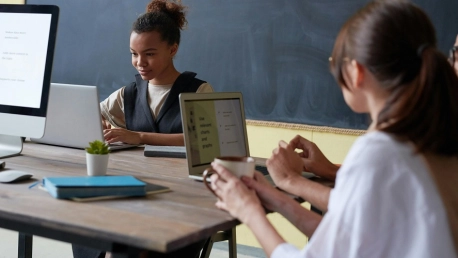With how quickly the world is changing and moving into a direction where tech and AI reign supreme, education is one of the areas that will need to adapt the most. It’s not enough anymore to teach kids standard subjects like geography and math. There’s a real need out there now for the system to take on a whole new approach that adopts a more forward-thinking mindset. Industries across the board are looking for individuals who can think out of the box and bring groundbreaking ideas to the table—that doesn’t just happen. This is why we need to cultivate innovative mindsets from an early age.
In this article, we’ll look at all the different education models found today that are designed to take young students and transform them into entrepreneurs who like to innovate. We’ll also dive into how they’re being implemented and how important educators are to this process.
Innovation-Centric Education
Traditionally, education was all about rote learning and lots of standardized tests. Back in the day, you’d perhaps find students sitting in their rows and listening quietly to the teacher while they read the lesson straight out of the textbook. The learning was more about memorizing the work and repeating it in exams, leaving absolutely no space for creativity and free thinking. Nowadays, things are completely different, and modern methods focus on problem-solving, critical thinking, and creativity.
Technology’s Part in the Change
Technology integration plays a pivotal role in facilitating this educational shift. Digital tools and resources have transformed traditional classrooms into dynamic learning environments. Through the use of interactive software, virtual reality (VR), and augmented reality (AR), students can engage in immersive learning experiences that were not possible before. For example, VR can transport students to historical sites or simulate complex scientific phenomena, providing a richer understanding of the material.
Moreover, technology like artificial intelligence (AI) is being used to personalize learning paths for students, adapting to their individual strengths and weaknesses and allowing them to learn at their own pace. These technological advancements not only enhance educational experiences but also help cultivate an innovative mindset by enabling creative interactions with the content.
Key Elements of Innovative Education Models
Project-Based Learning (PBL) is a very different classroom approach compared to traditional methods that encourage students to explore problems that are faced in the real world and learn through reasoning it out with the rest of the class. Learning through theory alone isn’t the way anymore, and now, students can see the lesson unfold before their eyes by engaging with the problem physically. The benefits of PBL are that it not only enhances critical thinking and problem-solving skills but also improves student engagement and knowledge retention.
An Interdisciplinary Approach to education involves integrating multiple subject areas to provide a more comprehensive understanding of topics. This approach helps in breaking down the barriers between subjects traditionally seen as separate and distinct. By combining elements of science, technology, engineering, arts, and mathematics—sometimes referred to as STEAM—educators can provide a more enriched learning experience that encourages innovation and creativity.
Collaborative Learning is another crucial part of innovative education models. This strategy requires students to work together in groups, solve problems, finish projects, or understand new ideas. The importance of teamwork in creating innovations cannot be overstated. By learning collaboratively, students learn to communicate effectively, delegate tasks, and respect different viewpoints, all of which are essential in any innovative process.
Challenges in Implementing Innovation in Education
There are quite a few obstacles when you start to implement a new education model, and a lot of schools face a lack of resources in this regard. To add to the struggle, thousands of schools also need to deal with way too little funding, which can make educators feel like their hands are tied. Plus, even in situations where funding is available, the cost of the time associated with training teachers and updating curriculums can be too high. This digital divide in technology causes educational inequalities to get so much worse and leaves students at a disadvantage without the necessary equipment.
Resistance to Change
If you think that the digital divide is already a mountain of challenge, then the overall resistance to change is a whole new ball game. There are so many schools that are stuck in their ways of traditional teaching that even considering a new system or way of learning is a complete no-go. Granted, many institutions have had great success in the past with these models, but what they struggle to see is that they have become all but outdated. This leaves these pupils one step behind the others who are allowed a dynamic learning environment.
Scaling and Adaptability
Scaling innovative educational models to suit different regions and demographics presents another set of challenges. What works well in one cultural or economic context may not be suitable in another. For instance, a technology-driven curriculum may be highly effective in urban schools with good internet connectivity and digital literacy but may fail in rural or remote areas where such infrastructure is lacking.
Similarly, educational innovations must be adaptable to different learning styles and needs, requiring educators to continuously refine and customize their approaches. This necessity for adaptability can complicate the process of implementing broad-scale changes in the education system and requires a thoughtful, tailored approach to ensure inclusivity and effectiveness across diverse student populations.
Educators Creating Tomorrow’s Innovators
Mentors and role models genuinely play a super important role when it comes to shaping students’ attitudes and what they’re capable of. When an educator takes it a tiny step further and also acts as a mentor, it’s a double whammy of academics and life lessons all rolled into one invaluable combination that will ultimately lead to a generation of innovators. Effective mentorship involves guiding students through the process of ideation all the way through to experimentation and refinement of their projects. It also includes providing emotional and motivational support to encourage students to take risks and learn from failures.
Creating an Environment for Innovation
Educators can start building an environment that’s optimal for innovation by designing classroom spaces that are flexible and conducive to group work and discussions instead of just traditional lecture-style setups. Incorporating elements such as brainstorming sessions and idea incubators where students can freely explore and create will undoubtedly get their creative juices flowing and spark curiosity like never before.
Also, you want to have a classroom that really values open-mindedness and the confidence to explore and go further. It’s one thing for the student to know the material by heart, but being able to take the knowledge and apply it in various different ways shows a whole new level of understanding. Teachers should also encourage resilience and adaptability—key traits for innovative thinking—by helping students learn how to cope with and learn from failures and setbacks.
Final Thoughts
The future of education is heading into the most creative and innovative space it has ever been in. One can’t help but be excited when thinking about how it will help students reach far beyond what they ever thought they could achieve.
As digital technologies continue to permeate every aspect of our lives, educational institutions will likely place even greater emphasis on preparing students not just to participate in the world but to actively shape it. In embracing these changes, we pave the way for a generation of learners equipped to tackle the world’s most pressing challenges with resilience and ingenuity. This leads us to a future in which limits are only defined by how far their imaginations can reach.









